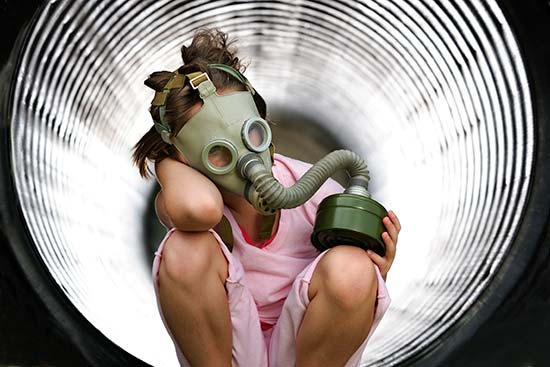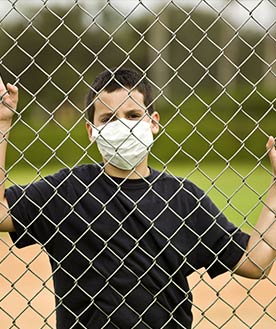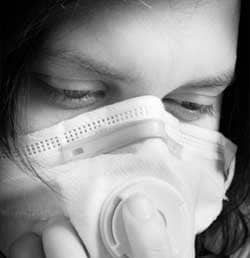Indoor Pollution – The Silent Killer
One often spots people with a mask across their faces, with only their eyes showing when outside their homes. Why, you ask? To filter the air they breathe and minimise the risk that air pollution poses to their health.
They pull it off once they enter their home. That’s because each and every one of us likes to believe that the air we breathe at home is clean. However, that is not the case.
Indoor pollution is a grave and dangerous problem that needs to be dealt with on priority. According to Teri, a research institute that works in the fields of energy, environment and sustainable development, indoor pollution refers to the physical, chemical, and biological characteristics of air in the indoor environment within a home, a building, an institution or a commercial facility.
According to the Global Burden of Disease Study, Indoor pollution is a major contributor to ill-health and pre-mature mortality rates in India. “About 2.8 billion (280 crore) people are exposed to indoor pollution across the globe out of which 780 million (78 crore) people are in India,” according to Dr K Srinath Reddy of Public Health Foundation of India.
Indoor air pollution in rural setups
In a developing country like India, it is the rural areas that face the greatest threat from indoor pollution. An estimated 142 million (14.2 crore) rural households (which accounts to 85% of total rural households) use firewood and solid fuels like animal dung, charcoal, as their primary source for cooking and heating.
Ventilation is another major problem. If food is cooked on chulhas within the walls of the house with not enough ventilation, the emissions from the solid fuels can be very damaging. On being burnt, solid fuels emit particulates, carbon monoxide, nitrogen oxides, benzene, formaldehyde, 1,3-butadiene, and polyaromatic compounds such as benzo(α)pyrene. These pollutants from solid fuel burning lead to serious health problems such acute lower respiratory infection, chronic obstructive pulmonary disorder, lung cancer (from exposure to biomass and coal smoke), asthma, cataract, to name a few.
Indoor air pollution in urban setups
From the cleaning agents used at home to perfumes sprayed to pet animals, everything leads to indoor pollution at homes. Here are a few common indoor pollutants and the health hazards they lead to:
Pollutant: Environmental Tobacco Smoke (ETS)
Source: Cigarette smoke
Tobacco releases a lot of chemicals into the air and is known to cause cancer. You may not be a smoker yourself, but even second-hand smoke can have adverse effects on your health.
Health Hazards: Respiratory irritation, bronchitis and pneumonia in children, emphysema, lung cancer, and heart disease
Pollutant: Radon
Source: Soil under buildings, some earth-derived construction materials, and groundwater
Radon gas is a radioactive gas that comes from the natural breakdown of uranium in soil, rock and water. When the uranium breaks down, the radon gas seeps up and can get into buildings. Radon is especially dangerous because it is both colourless and odourless, which makes it impossible to detect without special testing equipment.
Health Hazards: Lung cancer
Pollutant: Volatile organic compounds
Source: Solvents and chemicals in perfumes, hair sprays, furniture polish, glues, air fresheners, moth repellents, wood preservatives
Health Hazards: Irritation in the eye, nose and throat. In more severe cases there may be headaches, nausea and loss of coordination. In the long term, some of the pollutants are also suspected to damage to the liver and other parts of the body.
Pollutant: Formaldehyde
Source: It’s a gas that comes mainly from carpets, particle boards
Health Hazards: Exposure causes irritation to the eyes, nose and may cause allergies in some people.
Biological pollutants
Source: Pet dander, mites, dust, fungi, parasites all allergens that cause asthma
Health Hazards: These are mostly allergens that can cause asthma, hay fever, and other allergic diseases.
Pollutant: Lead
Source: Sanding or open-flame burning of lead paint; house dust
Heath Hazards: Nerve and brain damage, particularly in children; anemia; kidney damage; cardiovascular effects; growth retardation
Pollutant: Carbon Monoxide and Nitrogen dioxide
Source: Tobacco smoke, heaters, gas stoves, furnaces
Health Hazards: Among other things, carbon monoxide attacks the bloodstream and central nervous system. Exposure to low-level doses of carbon monoxide can cause nausea, dizziness, headaches, lack of coordination, ingestion etc. It can be fatal if one comes into contact with too much of it.
(With inputs from Mr. Shekhar Chandran, Centre for Science and Environment)
Read more:
Quiz: Are You a Polluter?
10 Remedies to Tackle Indoor Pollution
5 Things Government Needs to do to Improve Air Quality





I for all time emailed this website post page to all my associates, as if like to read it afterward my links will too.
Thanks for sharing your info. I really appreciate your efforts and I will be waiting for your next write ups thank you once again.
Great topic. I must spend a while learning more or understanding more. Thanks for fantastic information I used to be searching for this info for my mission.